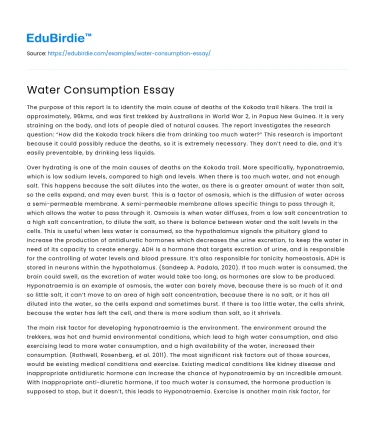The purpose of this report is to identify the main cause of deaths of the Kokoda trail hikers. The trail is approximately, 96kms, and was first trekked by Australians in World War 2, in Papua New Guinea. It is very straining on the body, and lots of people died of natural causes. The report investigates the research question: “How did the Kokoda track hikers die from drinking too much water?” This research is important because it could possibly reduce the deaths, so it is extremely necessary. They don’t need to die, and it’s easily preventable, by drinking less liquids.
Over hydrating is one of the main causes of deaths on the Kokoda trail. More specifically, hyponatraemia, which is low sodium levels, compared to high and levels. When there is too much water, and not enough salt. This happens because the salt dilutes into the water, as there is a greater amount of water than salt, so the cells expand, and may even burst. This is a factor of osmosis, which is the diffusion of water across a semi-permeable membrane. A semi-permeable membrane allows specific things to pass through it, which allows the water to pass through it. Osmosis is when water diffuses, from a low salt concentration to a high salt concentration, to dilute the salt, so there is balance between water and the salt levels in the cells. This is useful when less water is consumed, so the hypothalamus signals the pituitary gland to increase the production of antidiuretic hormones which decreases the urine excretion, to keep the water in need of its capacity to create energy. ADH Is a hormone that targets excretion of urine, and is responsible for the controlling of water levels and blood pressure. It’s also responsible for tonicity homeostasis, ADH is stored in neurons within the hypothalamus. (Sandeep A. Padala, 2020). If too much water is consumed, the brain could swell, as the excretion of water would take too long, as hormones are slow to be produced. Hyponatraemia is an example of osmosis, the water can barely move, because there is so much of it and so little salt, it can’t move to an area of high salt concentration, because there is no salt, or it has all diluted into the water, so the cells expand and sometimes burst. If there is too little water, the cells shrink, because the water has left the cell, and there is more sodium than salt, so it shrivels.
The main risk factor for developing hyponatraemia is the environment. The environment around the trekkers, was hot and humid environmental conditions, which lead to high water consumption, and also exercising lead to more water consumption, and a high availability of the water, increased their consumption. (Rothwell, Rosenberg, et al. 2011). The most significant risk factors out of those sources, would be existing medical conditions and exercise. Existing medical conditions like kidney disease and inappropriate antidiuretic hormone can increase the chance of hyponatraemia by an incredible amount. With inappropriate anti-diuretic hormone, if too much water is consumed, the hormone production is supposed to stop, but it doesn’t, this leads to Hyponatraemia. Exercise is another main risk factor, for developing hyponatraemia, this is due to the fact, that when you exercise, you lose some water through sweat, to cool your body down. This is a factor of homeostasis, and more water is consumed afterwards. This finding was inconsistent with the first finding, as the first focused on exercise associated hyponatraemia, and the second focused on the normal risk factors of hyponatraemia, the second didn’t mention high availability of water, because the first was about walking the Kokoda track, and the second, more a medical risk factors, about illnesses and diseases. The most significant finding was the environment, if it was unsuitable for the person doing the Kokoda walk, they would drink more water, which with other complications, like high availability to water, leads to hyponatraemia. As the body can’t keep up with the consumption of water, the sodium is diluted, and the water levels are greater than the salt levels. The Kokoda track hikers died of hyponatraemia, by this, because they were consuming too much water, and couldn’t excrete it fast enough. Plasma osmolality, is when there is less than 285 mmol/L, which confirms the presence of hypotonic solutions in the body. When there is hypotonic solutions, hyponatraemia can occur, this is below 136 mmol/L. Plasma osmolality is the balance of electrolytes in urine so hyponatraemia is a common electrolyte abnormality. Hyponatremia may be because the body stops ADH production, but it couldn’t excrete fast enough. The tissue fluids were less salty than the fluid outside the cells. Some other risk factors of developing hyponatremia are age, certain drugs, existing medical conditions, like kidney disease, inappropriate anti-diuretic hormone and other conditions which decreases water excretion. (Mayo Clinic, 2018).
Some limitations of their research was that the water consumption of the people they tested was estimated, their weight was also estimated. The authors had also told them they were doing testing so they may have been more careful with their water consumption. Their sample size could have been a bit bigger, so the evidence was more accurate. This study was completed 10 years ago, so the technology they used was fairly new, and may have been updated since then.
The aim of this report was to investigate the research question, “How did the Kokoda track hikers die from drinking too much water?” The main findings from these papers is that when there are low sodium levels, and high water levels, hyponatraemia occurs. The findings from the paper clearly show the link between overconsumption of water, and hyponatraemia. This is explained by that the water dilutes the sodium, and causes implications on the body. In the case of the Kokoda track hikers, hyponatraemia was caused by the high availability of water, and exercising, and an excess amount of drinking liquids.






 Stuck on your essay?
Stuck on your essay?

